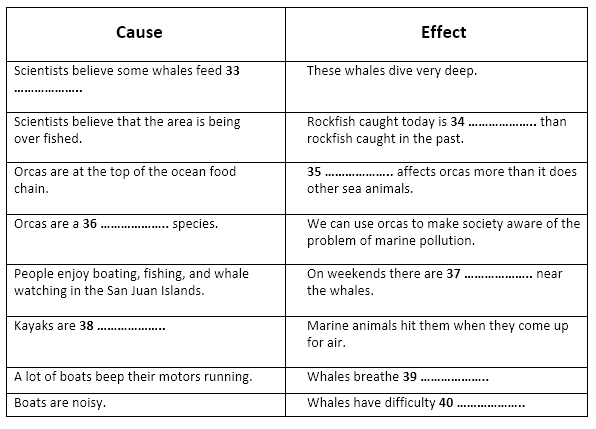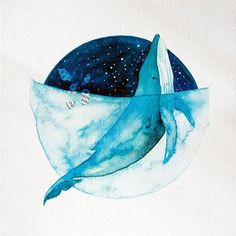DỊCH HOÀN THIỆN ĐỀ THI IELTS READING VÀ GIẢI THÍCH ĐÁP ÁN:
Issues Affecting the Southern Resident Orcas
A. Orcas, also known as killer whales, are opportunistic feeders, which means they will take a variety of different prey species. J, K, and L pods (specific groups of orcas found in the region) are almost exclusively fish eaters. Some studies show that up to 90 percent of their diet is salmon, with Chinook salmon being far and away their favorite. During the last 50 years, hundreds of wild runs of salmon have become extinct due to habitat loss and overfishing of wild stocks. Many of the extinct salmon stocks are the winter runs of chinook and coho. Although the surviving stocks have probably been sufficient to sustain the resident pods, many of the runs that have been lost were undoubtedly traditional resources favored by the resident orcas. This may be affecting the whales’ nutrition in the winter and may require them to change their patterns of movement in order to search for food. ĐOẠN 1
Cá kình, còn được gọi là cá voi sát thủ, là loài kiếm ăn cơ hội, có nghĩa là chúng sẽ bắt nhiều loài con mồi khác nhau. Nhóm cá voi J, K và L (các nhóm cá kình cụ thể được tìm thấy trong khu vực) hầu như chỉ ăn cá. Một số nghiên cứu cho thấy rằng có tới 90 phần trăm chế độ ăn uống của chúng là cá hồi, trong đó cá hồi Chinook là món khoái khẩu đặc biệt của chúng. Trong 50 năm qua, hàng trăm loài cá hồi hoang dã đã tuyệt chủng do mất môi trường sống và đánh bắt quá mức nguồn dự trữ tự nhiên. Nhiều đàn cá hồi đã tuyệt chủng là loại cá hồi mùa đông chinook và coho. Mặc dù nguồn dự trữ còn sót lại có thể đủ để nuôi sống những con cá voi trú ngụ, nhưng nhiều loại bị mất chắc chắn là nguồn tài nguyên truyền thống được cá voi sát thủ trú ngụ ưa chuộng . Điều này có thể ảnh hưởng đến dinh dưỡng của cá voi trong mùa đông và có thể khiến chúng phải thay đổi kiểu di chuyển để tìm kiếm thức ăn.
*** “Far and away” : bỏ xa, hơn hẳn, đặc biệt không thể so sánh được
run( danh từ): loại, hạng thứ
Other studies with tagged whales have shown that they regularly dive up to 800 feet in this area. Researchers tend to think that during these deep dives the whales may be feeding on bottomfish. Bottomfish species in this area would include halibut, rockfish, lingcod, and greenling. Scientists estimate that today’s lingcod population in northern Puget Sound and the Strait of Georgia is only 2 percent of what it was in 1950. The average size of rockfish in the recreational catch has also declined by several inches since the 1970s, which is indicative of overfishing. In some locations, certain rockfish species have disappeared entirely. So even if bottomfish are not a major food resource for the whales, the present low number of available fish increases the pressure on orcas and all marine animals to find food. (For more information on bottomfish see the San Juan County Bottomfish Recovery Program.) ĐOẠN 2
Các nghiên cứu khác có cá voi được gắn thẻ đã chỉ ra rằng chúng thường xuyên lặn sâu tới 800 feet trong khu vực này. Các nhà nghiên cứu có xu hướng nghĩ rằng trong những lần lặn sâu này, cá voi có thể đang ăn cá sống ở tầng đáy. Các loài cá tầng đáy trong khu vực này sẽ bao gồm cá bơn, cá đá, cá mú bông, cá xanh. Các nhà khoa học ước tính rằng quần thể cá mú bông ngày nay ở phía bắc Puget Sound và Eo biển Georgia chỉ bằng 2% so với năm 1950. Kích thước trung bình của cá đá trong hoạt động đánh bắt giải trí cũng đã giảm vài inch kể từ những năm 1970, điều này cho thấy tình trạng đánh bắt quá mức . Ở một số địa điểm, một số loài cá đá đã biến mất hoàn toàn. Vì vậy, ngay cả khi cá ở đáy không phải là nguồn thức ăn chính của cá voi, thì số lượng cá sẵn có hiện nay thấp làm tăng áp lực tìm kiếm thức ăn đối với cá voi sát thủ và tất cả các động vật biển. (Để biết thêm thông tin về cá đáy, hãy xem Chương trình phục hồi cá đáy của Quận San Juan.)
B. Toxic substances accumulate in higher concentrations as they move up the food chain. Because orcas are the top predator in the ocean and are at the top of several different food chains in the environment, they tend to be more affected by pollutants than other sea creatures. Examinations of stranded killer whales have shown some extremely high levels of lead, mercury, and polychlorinated hydrocarbons. Abandoned marine toxic waste dumps and present levels of industrial and human refuse pollution of the inland waters probably presents the most serious threat to the continued existence of this orca population. Unfortunately, the total remedy to this huge problem would be broad societal changes on many fronts. But because of the fact that orcas are so popular, they may be the best species to use as a focal point in bringing about the many changes that need to be made in order to protect the marine environment as a whole from further toxic poisoning.' ĐOẠN 3

1. Mua bộ đề gần 400 bài ielts reading - Dịch và giải chi tiết Chỉ 199k bao gồm toàn bộ đề trong bộ Cambridge ( từ bộ 1 -19) và nhiều đề thi thực tế ( xem danh sách 400 đề ielts reading tại đây). Xem bài mẫu tại đây, Bài mẫu 1, bài mẫu 2, bài mẫu 3. Giải đề bao gồm phần dịch bài đọc, dịch phần câu hỏi, giải thích chi tiết, ( chỉ có thể tải, in phần đề để luyện tập, phần giải chi tiết và dịch chỉ xem online).
>>>>>>> Đặc biệt tặng kèm Dịch và giải chi tiết bộ đề Ielts listening từ Cam 10-18 và tặng kèm hơn 300 đề Ielts thực tế ( không có lời giải chi tiết chỉ có đề và đáp án) ( khác với bộ 400 đề ở trên). Vui lòng điền thông tin theo form tại đây và thanh toán theo thông tin CK trong form.
2. Đặc biệt dành tặng 100 bạn hoàn thành buổi học thử miễn phí khóa học Ielts Speaking online 1 kèm 1, các bạn sẽ được tặng bộ đề 400k bài Ielts reading và bộ đề Ielts Listening bộ Cam từ 10-18 gồm bài dịch và giải chi tiết, giải thích từ vựng khó ( thời hạn sử dụng trong vòng 2 tháng). Xem thông tin khóa học Ielts Speaking online 1 kèm 1 và đăng ký học thử tại đây.
C. The waters around the San Juan Islands are extremely busy due to international commercial shipping, fishing, whale watching, and pleasure boating. On a busy weekend day in the summer, it is not uncommon to see numerous boats in the vicinity of the whales as they travel through the area. The potential impacts from all this vessel traffic with regard to the whales and other marine animals in the area could be tremendous. ĐOẠN 4
The surfacing and breathing space of marine birds and mammals is a critical aspect of their habitat, which the animals must consciously deal with on a moment-to-moment basis throughout their lifetimes. With all the boating activity in the vicinity, there are three ways in which surface impacts are most likely to affect marine animals: (a) collision, (b) collision avoidance, and (c) exhaust emissions in breathing pockets. ĐOẠN 5
The first two impacts are very obvious and don’t just apply to vessels with motors. Kayakers even present a problem here because they’re so quiet. Marine animals, busy hunting and feeding under the surface of the water, may not be aware that there is a kayak above them and actually hit the bottom of it as they surface to breathe. ĐOẠN 6
The third impact is one most people don’t even think of. When there are numerous boats in the area, especially idling boats, there are a lot of exhaust fumes being spewed out on the surface of the water. When the whale comes up to take a nice big breath of “fresh" air, it instead gets a nice big breath of exhaust fumes. It’s hard to say how greatly this affects the animals, but think how breathing polluted air affects us (i.e., smog in large cities like Los Angeles, breathing the foul air while sitting in traffic jams, etc). ĐOẠN 7
D. Similar to surface impacts, a primary source of acoustic pollution for this population of orcas would also be derived from the cumulative underwater noise of vessel traffic. For cetaceans, the underwater sound environment is perhaps the most critical component of their sensory and behavioral lives. Orcas communicate with each other over short and long distances with a variety of clicks, chirps, squeaks, and whistles, along with using echolocation to locate prey and to navigate. They may also rely on passive listening as a primary sensory source. The long-term impacts from noise pollution would not likely show up as noticeable behavioral changes in habitat use, but rather as sensory damage or gradual reduction in population health. A new study at The Whale Museum called the Sea Sound Remote Sensing Network has begun studying underwater acoustics and its relationship to orca communication. ĐOẠN 8
>>>>> Xem thêm:
♦ Tổng hợp câu trả lời, câu hỏi, từ vựng của hơn 70 chủ đề Ielts Speaking part 1
♦ Tổng hợp gần 400 đề thi Ielts reading ( bao gồm dịch, giải chi tiết, từ vựng)
Questions 27-30
Reading Passage 187 has four sections (A-D). Choose the most suitable heading for each section from the list of headings below.
Write the appropriate numbers (i-vii) in boxes 27-30 on your Answer Sheet
There are more headings than sections, so you will not use all of them.
27. Section A
28. Section B
29. Section C
30. Section D
List of Headings
i. Top Ocean Predators
ii. Toxic Exposure
iii. Declining Fish Populations
iv. Pleasure Boating in the San Juan Islands
v. Underwater Noise
vi. Smog in Large Cities
vii. Impact of Boat Traffic
Questions 31-32
For each question, choose the appropriate letter A-D and write it in boxes 31 and 32 on your Answer Sheet
31. Killer whales (orcas) in the J, K, and L pods prefer to eat
A) halibut.
B) a type of salmon.
C) a variety of animals.
D) fish living at the bottom of the sea.
32. Some groups of salmon have become extinct because
A) they have lost places to live.
B) whales have eaten them.
C) they don't get good nutrition.
D) the winters in the area are too cold.
Questions 33-40
Complete the chart below.
Choose NO MORE THAN THREE WORDS for each answer. Write your answers in boxes 33-40 on your Answer Sheet.

DỊCH HOÀN THIỆN ĐỀ THI IELTS READING VÀ GIẢI THÍCH ĐÁP ÁN:
Issues Affecting the Southern Resident Orcas
Questions 27-30
Reading Passage 187 has four sections (A-D). Choose the most suitable heading for each section from the list of headings below.
Write the appropriate numbers (i-vii) in boxes 27-30 on your Answer Sheet
There are more headings than sections, so you will not use all of them.
27. Section A/ iii. Declining Fish Populations
Giải thích:
Some studies show that up to 90 percent of their diet is salmon, with Chinook salmon being far and away their favorite. During the last 50 years, hundreds of wild runs of salmon have become extinct due to habitat loss and overfishing of wild stocks. Many of the extinct salmon stocks are the winter runs of chinook and coho.
The average size of rockfish in the recreational catch has also declined by several inches since the 1970s, which is indicative of overfishing. In some locations, certain rockfish species have disappeared entirely. So even if bottomfish are not a major food resource for the whales, the present low number of available fish increases the pressure on orcas and all marine animals to find food.
28. Section B/ ii. Toxic Exposure
Giải thích:
Toxic substances accumulate in higher concentrations as they move up the food chain. Because orcas are the top predator in the ocean and are at the top of several different food chains in the environment, they tend to be more affected by pollutants than other sea creatures.
Questions 31-32
For each question, choose the appropriate letter A-D and write it in boxes 31 and 32 on your Answer Sheet
31. Killer whales (orcas) in the J, K, and L pods prefer to eat
Cá voi sát thủ (orcas) ở nhóm J, K và L thích ăn
A) halibut.
cá bơn.
B) a type of salmon.
một loại cá hồi.
Giải thích: đoạn A ( 1)
J, K, and L pods (specific groups of orcas found in the region) are almost exclusively fish eaters. Some studies show that up to 90 percent of their diet is salmon, with Chinook salmon being far and away their favorite.
C) a variety of animals.
nhiều loại động vật.
D) fish living at the bottom of the sea.
cá sống dưới đáy biển.
Questions 33-40
Complete the chart below.
Choose NO MORE THAN THREE WORDS for each answer. Write your answers in boxes 33-40 on your Answer Sheet.

33. on bottomfish
Giải thích: đoạn A (2)
Other studies with tagged whales have shown that they regularly dive up to 800 feet in this area. Researchers tend to think that during these deep dives the whales may be feeding on bottomfish
34. Rockfish caught today is ........less........ than rockfish caught in the past
Cá đá đánh bắt ngày nay ít hơn cá đá đánh bắt ngày xưa
Giải thích: đoạn A
The average size of rockfish in the recreational catch has also declined by several inches since the 1970s, which is indicative of overfishing.
35. pollution
Giải thích: đoạn B (3)
Toxic substances accumulate in higher concentrations as they move up the food chain. Because orcas are the top predator in the ocean and are at the top of several different food chains in the environment, they tend to be more affected by pollutants than other sea creatures.
36. popular
Giải thích: đoạn B (3)
Unfortunately, the total remedy to this huge problem would be broad societal changes on many fronts. But because of the fact that orcas are so popular, they may be the best species to use as a focal point in bringing about the many changes that need to be made in order to protect the marine environment as a whole from further toxic poisoning.
Answer:
27. iii
28. ii
29. vii
30. v
31. B
32. A
33. on bottomfish
34. less
35. pollution
36. popular
37. numerous boats/vessels
38. quiet
39. exhaust fumes
40. communicating (with others)
1. Mua bộ đề gần 400 bài ielts reading - Dịch và giải chi tiết Chỉ 199k bao gồm toàn bộ đề trong bộ Cambridge ( từ bộ 1 -19) và nhiều đề thi thực tế ( xem danh sách 400 đề ielts reading tại đây). Xem bài mẫu tại đây, Bài mẫu 1, bài mẫu 2, bài mẫu 3. Giải đề bao gồm phần dịch bài đọc, dịch phần câu hỏi, giải thích chi tiết, ( chỉ có thể tải, in phần đề để luyện tập, phần giải chi tiết và dịch chỉ xem online).
>>>>>>> Đặc biệt tặng kèm Dịch và giải chi tiết bộ đề Ielts listening từ Cam 10-18 và tặng kèm hơn 300 đề Ielts thực tế ( không có lời giải chi tiết chỉ có đề và đáp án) ( khác với bộ 400 đề ở trên). Vui lòng điền thông tin theo form tại đây và thanh toán theo thông tin CK trong form.
2. Đặc biệt dành tặng 100 bạn hoàn thành buổi học thử miễn phí khóa học Ielts Speaking online 1 kèm 1, các bạn sẽ được tặng bộ đề 400k bài Ielts reading và bộ đề Ielts Listening bộ Cam từ 10-18 gồm bài dịch và giải chi tiết, giải thích từ vựng khó ( thời hạn sử dụng trong vòng 2 tháng). Xem thông tin khóa học Ielts Speaking online 1 kèm 1 và đăng ký học thử tại đây.

.png)

.jpg)




